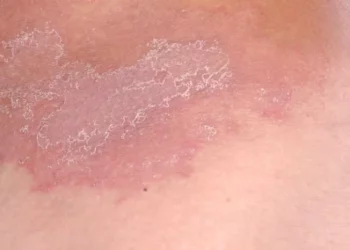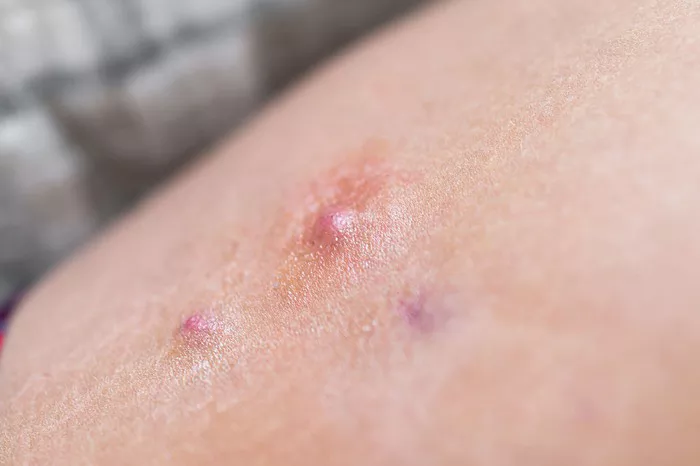Ringworm, despite its deceiving name, has nothing to do with worms. Instead, it’s a common fungal infection that affects the skin, scalp, or nails. Its hallmark symptom often includes a burning sensation, accompanied by itching and discomfort. Understanding the reasons behind why ringworm burns involves exploring the intricate interactions between the invading fungi and the body’s immune system. In this comprehensive article, we’ll delve into the definition of ringworm, its causes, home remedies, when to seek medical attention, and prevention tips, providing a thorough understanding of this irritating condition.
Definition of Ringworm
Ringworm, scientifically known as dermatophytosis, derives its name from the characteristic red, circular rash it produces, resembling a ring. However, this condition is not caused by worms but rather by various species of fungi, including Trichophyton, Microsporum, and Epidermophyton. These fungi thrive in warm, moist environments and are highly contagious, spreading through direct contact with infected individuals or contaminated objects such as clothing, towels, or surfaces.
Ringworm manifests differently depending on its location:
1. Cutaneous Ringworm: This type affects the skin and typically presents as red, scaly patches with well-defined borders. It can occur anywhere on the body and is often accompanied by itching, burning, or both.
2. Scalp Ringworm: Also known as tinea capitis, this form affects the scalp and hair follicles. It can cause hair loss, scaling, and inflammation of the affected area.
3. Nail Ringworm: Known as onychomycosis, this variant affects the nails, causing them to become thick, discolored, and brittle. It can be challenging to treat and may require prolonged therapy.
Regardless of its location, ringworm is characterized by its fungal nature and contagiousness, making prompt diagnosis and treatment essential to prevent its spread.
Causes of Burning Sensation
The burning sensation associated with ringworm arises from the body’s inflammatory response to fungal invasion. When fungi come into contact with the skin, they trigger an immune reaction aimed at eliminating the foreign invaders. This response involves the release of inflammatory mediators such as histamine, cytokines, and prostaglandins, which promote vasodilation, increase vascular permeability, and recruit immune cells to the site of infection.
As inflammation progresses, it leads to redness, swelling, and itching, characteristic symptoms of ringworm. However, the burning sensation occurs as a result of the irritation of nerve endings in the affected area. Inflammation can sensitize these nerve endings, making them more responsive to stimuli and amplifying sensations of pain and discomfort.
Additionally, the release of certain chemicals by immune cells, such as bradykinin and substance P, can directly stimulate nerve fibers, further contributing to the sensation of burning. This neuronal hyperactivity exacerbates the discomfort experienced by individuals with ringworm, prompting them to seek relief through scratching.
Impact of Scratching
While scratching may provide temporary relief from itching and burning, it can exacerbate the irritation and inflammation associated with ringworm. The act of scratching can damage the skin, creating microtears that allow bacteria from under the fingernails to enter the body. This can lead to secondary bacterial infections, complicating the healing process and prolonging the duration of symptoms.
Moreover, scratching can spread the fungal infection to adjacent areas of the skin, increasing the risk of further outbreaks. It can also disrupt the skin’s barrier function, making it more susceptible to secondary infections and delaying the resolution of ringworm.
To minimize the risk of complications, it’s essential to avoid scratching the affected area and to seek appropriate treatment to alleviate symptoms and promote healing.
Home Remedies and OTC Treatments
Fortunately, ringworm can often be effectively treated with over-the-counter (OTC) antifungal medications. These medications come in various forms, including creams, ointments, and powders, and contain active ingredients such as clotrimazole, miconazole, or terbinafine. These antifungal agents work by inhibiting the growth and reproduction of fungi, thereby reducing the severity of symptoms and promoting healing.
In addition to antifungal treatments, several home remedies can help alleviate the discomfort associated with ringworm:
1. Cool Compresses: Applying cool compresses to the affected area can provide relief from itching and burning. The cool temperature helps numb the nerves and reduce inflammation, providing temporary relief from discomfort.
2. Oatmeal Baths: Taking oatmeal baths can soothe irritated skin and reduce inflammation. Oatmeal contains compounds that have anti-inflammatory properties and can help alleviate itching and burning associated with ringworm.
3. Keeping the Infected Area Clean and Dry: It’s essential to keep the infected area clean and dry to prevent further irritation and promote healing. Avoiding tight clothing and wearing breathable fabrics can help minimize sweating and keep the skin dry.
4. Avoiding Harsh Chemicals: Avoid using harsh soaps or cleansers on the affected area, as these can further irritate the skin and exacerbate symptoms. Opt for gentle, fragrance-free products that are suitable for sensitive skin.
While home remedies can provide symptomatic relief, they may not always be sufficient to eliminate the fungal infection entirely. If symptoms persist or worsen despite home treatment, it’s advisable to consult a healthcare professional for further evaluation and management.
When to Seek Medical Attention
While most cases of ringworm can be effectively managed at home, there are instances where medical attention is necessary. It is advisable to consult a doctor if:
1. The Infection is Widespread or Severe: If the ringworm infection covers a large area of the body or is particularly severe, medical intervention may be required. In such cases, prescription-strength antifungal medications may be necessary to eradicate the infection.
2. Home Treatment Shows No Improvement: If home treatment fails to improve symptoms after a reasonable period, typically one to two weeks, medical evaluation is warranted. Persistent or worsening symptoms may indicate an underlying condition or the need for alternative treatment approaches.
3. The Infection Involves the Scalp or Nails: Ringworm infections involving the scalp or nails can be challenging to treat and may require specialized care. These types of infections often necessitate oral antifungal medications and may require prolonged therapy to achieve resolution.
4. The Individual has a Weakened Immune System: Individuals with weakened immune systems, such as those with HIV/AIDS, diabetes, or cancer, are at increased risk of developing complications from ringworm infections. They may require more aggressive treatment and close monitoring to prevent the spread of infection and minimize the risk of complications.
In any of these scenarios, seeking medical attention promptly can help ensure proper diagnosis and treatment, reducing the risk of complications and promoting faster recovery.
Prevention Tips
Preventing ringworm infection involves adopting various preventive measures to minimize exposure to the fungi responsible for the condition. Some tips for preventing ringworm include:
1. Practicing Good Hygiene: Wash hands regularly with soap and water, especially after touching animals or coming into contact with potentially contaminated surfaces. Encourage children to avoid sharing personal items such as towels, clothing, and grooming tools to prevent the spread of infection.
2. Keeping Skin Clean and Dry: Keeping the skin clean and dry can help prevent fungal infections by creating an environment that is less hospitable to fungi. Shower regularly, especially after engaging in activities that cause sweating, and dry off thoroughly afterward.
3. Avoiding Shared Personal Items: Avoid sharing personal items such as towels, clothing, and grooming tools with others, particularly if someone in the household has ringworm. Sharing personal items can facilitate the spread of infection and increase the risk of outbreaks.
4. Practicing Good Foot Hygiene: Wear clean socks and shoes, and avoid walking barefoot in public places such as locker rooms, swimming pools, and communal showers, where the fungi that cause ringworm can thrive. Keep feet clean and dry, and change socks and shoes regularly to minimize the risk of fungal infections.
5. Maintaining a Healthy Lifestyle: A healthy lifestyle can help boost the immune system and reduce the risk of fungal infections. Eat a balanced diet rich in fruits, vegetables, and whole grains, get regular exercise, and manage stress levels to support overall health and well-being.
By adopting these preventive measures, individuals can reduce their risk of ringworm infection and protect themselves and their families from this common fungal condition.
Conclusion
Ringworm is a common fungal infection that can cause a variety of symptoms, including itching, burning, and discomfort. Understanding why ringworm burns involves exploring the complex interactions between the invading fungi and the body’s immune system. By recognizing the inflammatory nature of fungal infections and adopting preventive measures to minimize exposure to the fungi responsible for ringworm, individuals can reduce their risk of infection and effectively manage symptoms if they occur. Prompt diagnosis and appropriate treatment are essential for preventing the spread of infection and minimizing the risk of complications, particularly in individuals with weakened immune systems or severe or persistent infections. With proper care and attention, ringworm can be successfully treated and managed, allowing affected individuals to regain comfort and confidence in their skin.
Related Topics:
The Best Practices for Diagnosing Tinea Infections

























